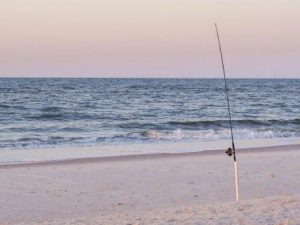Surf fishing along Alabama’s Gulf Coast has gained significant popularity, with many anglers drawn to the area’s pristine sugar-white sand beaches and abundant marine life. This year, the surf fishing has been particularly impressive, and it’s expected to get even better as the fall season approaches.
With daytime temperatures dropping to the mid-70s to low 80s, the water begins to cool, sparking a feeding frenzy among whiting and pompano. The cooler temperatures also reduce the presence of less desirable species, making it an ideal time to fish.
Targeting Pompano
Florida pompano, one of the most sought-after species in the surf, can be caught using pompano jigs or natural baits like peeled shrimp, sand fleas, and ghost shrimp. Local bait shops offer a variety of bait options, including fresh-dead shrimp and frozen sand fleas. Additionally, anglers can use a rake to collect live sand fleas from the beach or employ a suction pump to harvest ghost shrimp at the edge of the surf. Ghost shrimp, though delicate, can be an excellent bait if carefully secured to the hook. Adding a piece of Fish Bites to the hook can help keep the natural bait in place and enhance its appeal to fish.
When fishing for pompano or whiting, it’s crucial to use small hooks, such as a No. 6 Kahle or a small No. 8 circle hook, as these fish have relatively small mouths. It’s also important to conceal the hook within the bait, as pompano can be finicky eaters. Some anglers opt to cast natural bait into the surf while keeping an extra rod ready for casting pompano jigs. Blind-casting pompano jigs can be particularly productive in clear water conditions, allowing anglers to reach the three-fish limit (with a 12-inch minimum size) relatively quickly.
The most productive areas for surf fishing are typically where the first sandbar is close to the shoreline. Look for deeper, darker spots in the surf, which can indicate the presence of fish. Cast your bait into these areas, secure the rod in a holder, and enjoy the soothing sound of the surf while waiting for a bite.

Fishing for Whiting and Redfish
Whiting, or Gulf Kingfish, is another popular target in the fall. Although whiting are not large, with a two-pounder considered big, they are highly prized for their taste. When targeting whiting, use single-hook or two-hook rigs with a three-way swivel for the pyramid weight. The key is to use the smallest pyramid weight possible, adjusting based on the strength of the current. The absence of size or bag limits on whiting means that a successful day on the water could yield enough fish for a large fish fry.
Redfish also become more active in the fall, offering a thrilling challenge for surf anglers. These powerful fish can test tackle, especially when targeting larger specimens known as bull reds. Alabama enforces a 16-26 inch slot limit for redfish, with one fish over 26 inches allowed per angler. If a bull red is caught, many anglers prefer to release it after taking a few photos to allow the fish to fight another day. Cut mullet or live baitfish are effective for attracting reds, and a rod with a 15-20 pound line is recommended to handle the strength of these fish.
Flounder Fishing in the Fall
Flounder can also be caught during the fall, particularly during low-light conditions in the early morning. Anglers typically use minnow-imitation jigs, casting them in a fan pattern while walking along the surf. Alabama has a daily creel limit of five flounder, with a minimum size of 14 inches in total length. However, it’s important to note that any flounder caught in November must be released unharmed, as the season is closed during this time to protect the fish during their migration to spawning grounds.
This fall, the surf fishing along Alabama’s Gulf Coast promises to be exceptional, offering anglers a chance to experience the thrill of reeling in prized species like pompano, whiting, redfish, and flounder. With the right gear and a bit of patience, these beautiful beaches are sure to deliver an unforgettable fishing experience.
Image/Source: GulfShores





